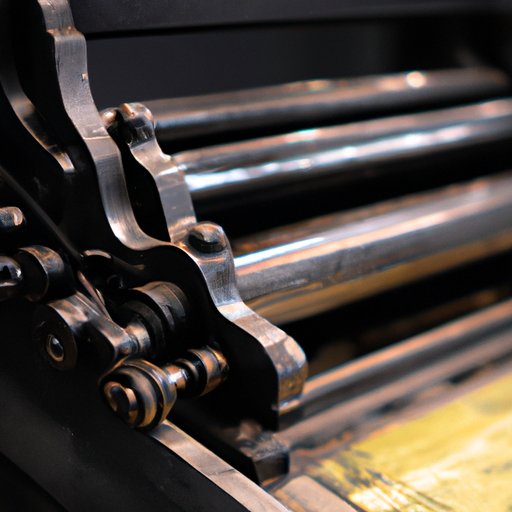Introduction
The printing press is one of the most important inventions in human history. It revolutionized communication, allowing ideas and information to be spread far and wide with unprecedented speed and efficiency. But who invented the printing press? That honor belongs to Johannes Gutenberg, a German blacksmith and inventor who lived in the 15th century.

Biography of Johannes Gutenberg and His Printing Press Invention
Johannes Gutenberg was born in Mainz, Germany in 1398. He was the son of a successful merchant and goldsmith, and from an early age he showed an aptitude for technology and engineering. As a young man, he apprenticed as a blacksmith and worked on perfecting his craft.
Gutenberg’s motivation for inventing the printing press came from his observations of wine presses and other devices used for pressing and shaping materials. He thought that if these machines could be used to shape objects, they could also be used to create prints. After several years of experimentation, he developed a system of movable type which allowed him to create multiple copies of documents quickly and efficiently.
Gutenberg continued to improve upon his invention over the course of the next decade. He began to use oil-based inks which were more durable and long-lasting than traditional water-based inks. He also added a wooden frame to the press, which allowed it to be operated with greater precision and accuracy. By 1448, he had perfected the printing press and was ready to put it into production.
A History of the Printing Press and Its Impact on Society
The invention of the printing press had a profound impact on society. It allowed for the rapid dissemination of knowledge and ideas, which resulted in increased literacy rates and a more educated population. The printing press was also instrumental in spreading religious texts, which played an important role in the Protestant Reformation.
In addition, the printing press helped to spur advances in education, politics, and literature. It allowed for the production of books and other educational materials at lower costs, making them more accessible to the general public. Politically, it allowed for the quick circulation of news and opinions, helping to shape public discourse. Finally, it enabled authors to reach wider audiences, leading to the development of new genres and styles of writing.

The Journey from Manuscripts to Print: How Gutenberg Changed the World
Before the invention of the printing press, all documents were written by hand, a process known as manuscript production. This method was time-consuming and labor-intensive, and it limited the amount of material that could be produced. Furthermore, manuscripts were expensive and only available to those who could afford them.
In contrast, Gutenberg’s printing press allowed for the mass production of documents at a much lower cost. It was faster, more efficient, and more accurate than manuscript production. Furthermore, it allowed for the widespread distribution of books and other materials, making them available to a larger audience.
Exploring the Technology Behind Gutenberg’s Printing Press
Gutenberg’s printing press was composed of several components, including a wooden frame, metal type, a press bed, and an ink roller. The type was arranged in a forme, a metal plate with raised letters and symbols. The forme was then placed on the press bed and inked with an ink roller. The paper was then laid on top of the forme and pressed down onto the type, transferring the ink from the type to the paper.
To produce multiple copies of a document, the entire process had to be repeated for each page. This was a labor-intensive process, but it allowed for the mass production of documents in a relatively short period of time.

An Overview of the Printing Press Through Time
Over the centuries, the printing press has undergone numerous changes and improvements. Early presses were powered by hand, but later models were driven by steam and other forms of power. Automation was introduced in the 19th century, allowing for even faster production speeds. Other advancements included the introduction of offset printing and digital printing.
Today, the printing press is still used for a variety of tasks, including printing newspapers, books, magazines, and other materials. Advances in technology have made the printing process faster, cheaper, and more efficient than ever before.
Examining Gutenberg’s Legacy: How Printing Shaped Human Civilization
Gutenberg’s invention of the printing press had a lasting impact on human civilization. It allowed for the rapid spread of knowledge and ideas, which resulted in a more informed and educated population. It also enabled the production of books and other materials at lower costs, making them more accessible to the general public.
In addition, the printing press helped to shape culture and communication. It allowed for the quick circulation of news and opinions, helping to shape public discourse. It also enabled authors to reach wider audiences, leading to the development of new genres and styles of writing.
Conclusion
Johannes Gutenberg’s invention of the printing press revolutionized communication and ushered in a new era of knowledge and understanding. His invention enabled the mass production of documents, making them available to a larger audience. It also helped to spur advances in education, politics, and literature. Finally, it had a lasting influence on culture and communication, helping to shape modern society. Gutenberg’s invention was truly revolutionary, and its impact is still felt today.
(Note: Is this article not meeting your expectations? Do you have knowledge or insights to share? Unlock new opportunities and expand your reach by joining our authors team. Click Registration to join us and share your expertise with our readers.)
